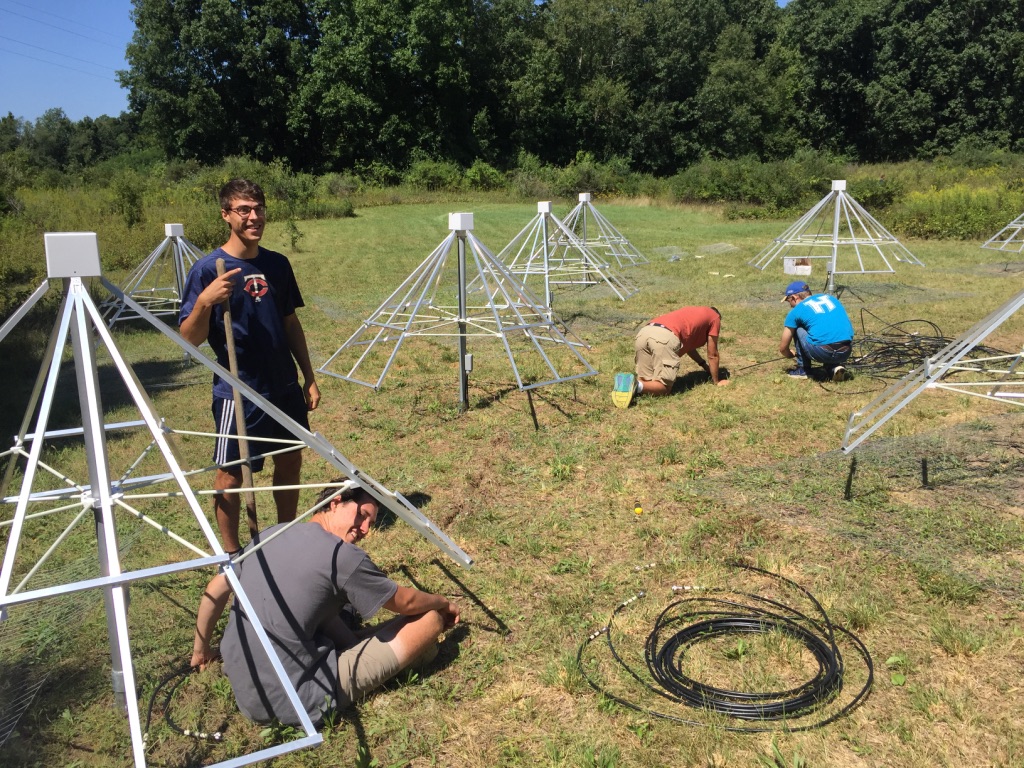
Five Hillsdale College students spent five weeks at the end of their summer digging trenches in Hayden Park, soldering cables, programming software, and analyzing data for a special radio astronomy project.
Under the supervision of Assistant Professor of Physics Timothy Dolch, the group constructed a radio telescope antenna array, called the Low-Frequency All-Sky Monitor, that will be used by the physics department as a lab. The new station joins four others across the country that communicate with each other, forming a collaborative telescope that detects and reads natural radio emissions coming from the sky. These signals show sudden, short astrophysical changes such as pulses from neutron stars in our own galaxy and possibly others.
“When you look at the sky in radio waves, it’s an invisible universe,” Dolch said. “There is a lot with radio waves that you can not see with your unaided eye … With the right telescope, the night sky would look like a field of fireflies.”
The benefit of a system such as this is the ability to observe the sky through radio waves at any time of the day or in any weather condition. Celestial bodies, such as the sun and Jupiter, appear very bright to the monitor due to the radio waves they emit through solar bursts and radio storms, Dolch explained.
While the causes of some radio flashes are known, that is not always the case.
“People can’t immediately explain the mechanisms which cause all of these explosions…there’s a lot of contending theories,” Dolch said. “This is a real gold mine for theoretical physicists to explain, and maybe even discover, new physics in the process.”
Senior Jay Rose is one of the five students working at the site. He has been using programming and electrical engineering skills at the site by working with the programming language Simulink, a MATLAB software, as well as the telescope’s Field-Programmable Gate Array, which processes incoming signals. Earlier in the summer, Rose spent eight weeks in China working with the National Astronomical Observatory of China (NAOC), where he had an internship at the Five-hundred-meter Aperture Spherical Telescope (FAST) in Pingtang, China, the largest radio telescope in the world.
The other students include sophomores Philip Andrews, Nathaniel Birzer, Sashabaw Niedbalski, and Caleb Ramette, who worked on construction and technical duties.
Ramette explained that the group used a spectrum analyzer to identify radio interference, determining the quality of the data.
“The radio frequency interference (RFI) could be thought of as analogous to light pollution for a telescope that operates in the visible spectrum,” Ramette said. “More RFI presence means that the data collected with the telescope will be limited.”
Dolch said that the array often picks up CB radio, FM stations, and activity at nearby houses. If a potential astrophysical signal is detected, the telescope’s computers will then send out alerts to the collaborating stations in West Virginia, Texas, New Mexico, and California. If the other stations notice the same activity, chances are the signals actually indicate some legitimate astrophysical change instead of RFI.
The site allows students to explore the increased interest in computer science and engineering at Hillsdale. During the construction of the site, students essentially practiced electrical engineering techniques.
“Now that we have the permanent site in place, it opens so many doors for ourselves and future students to use the instrument to study cutting edge physics like Fast Radio Bursts (FRBs), and I think that is pretty attractive to students interested in physics who are considering attending the college,” Andrews said.
Dolch said that while this type of station has never been located in a climate as cold as Hillsdale, the construction of the array allows it to work in all seasons, given proper maintenance.
“There were more than a few roadblocks along the way, and they were certainly frustrating to come up with and enact solutions for, but my fellow researchers and I, with Dr. Dolch’s guidance, were always able to work together as a team, which was the best part of the research,” Birzer said.
Andrews said he particularly enjoyed when the team rented a Ditch Witch machine, which allowed them to avoid manually digging more than 700 feet of trench to bury the array’s cables, allowing them to efficiently hide the wiring from animals that might otherwise chew them.
Dolch said that the station will not only be an educational resource for students in the physics department and his colleagues, but that other students also will have the opportunity to learn from the display.
“This is a chance for a small department from a school most people don’t think of as having as strong of sciences as it does to put its name in with research universities many times Hillsdale’s size, in a fast expanding area in physics,” Andrews said.

